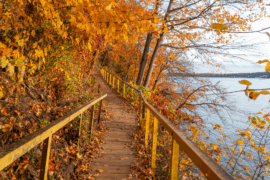Photo: ©Kevin Revolinski
Fun Fact: More than 3.4 million Wisconsinites live less than an hour’s drive from the Ice Age Trail, and five times as many can get to the trail in less than two.
The Ice Age Trail Alliance produces a trail guidebook and an updatable binder of over 100 colored trail maps. iceagetrail.org
WHAT DO I SEE?
Climb 500 feet up 1.6 billion-year-old bluff s overlooking a glacially-made lake, pass through prairie patches full of wildflowers, scan the horizon from the top of a glacial kame, trek along the narrow back of a long esker high above the forest floor and stroll the sandy shore of Lake Michigan or along the amazing Dells of the Eau Claire River—the terrain and vistas of the Ice Age National Scenic Trail (IAT) know no limits. One of 11 such federally honored trails, the amazing IAT is contained entirely within the borders of Wisconsin.
HOW LONG IS IT?
Yellow blazes on posts and trees guide hikers along footpaths traversing a combination of public lands and easements, along with some connecting roads through some of the fi nest scenery and wild places in the state. However, the trail isn’t fully completed yet—it’s still in development by teams of volunteer trail builders organized by the Ice Age Trail Alliance (IATA). Th e trail already has over 600 miles completed toward its planned 1,000 miles.
WHERE DOES IT PASS THROUGH?
Th e route, which roughly follows the edge of the last advance of the glaciers, is filled with eskers, drumlins, moraines and kames—the ice-carved stars of the IAT. The eastern terminus lies in Potawatomi State Park in Door County. From there the trail winds its way down through the Kettle Moraine area in a southbound loop that follows the Rock River through the center of Janesville, then works its way north along the western side of Madison, up the middle of the state to where it enters the Northwoods northeast of Wausau, bears west, and crosses to the western terminus inside Interstate Park on the St. Croix River.
CAN I HIKE SHORTER SEGMENTS OF IT?
Trail segments are measured point-to-point, one way. The 7.6-mile Chippewa Moraine Segment passes more than 20 kettle lakes, two primitive campsites and an interpretive center, but can be combined with 12.3 miles of uninterrupted trail to the east and on to Cornell’s Brunet Island State Park by connecting routes for a two-day hike. But the IAT also has a few good out-and-back options such as the 3.8-mile lollipop trail at Cedar Lakes Segment near Hartford. Whatever your skill level or time constraints, there’s a bit of the Ice Age Trail just for you.
THE LONG AND SHORT OF IT
Whether you have part of a day or a half-week, there are plenty of ways to explore the IAT. Use the interactive Hiker Resource Map on iceagetrail.org to find these segments by name, or purchase the organization’s guidebook and map atlas.
1 TO 2 HOURS
- Cedar Lake (3.8 mi r/t)
- Indian Lake (2.9 mi)
- John Muir Park (1.7 mi r/t)
- Dells of the Eau Claire (2.6 mi)
HALF-DAY
- Brooklyn (3.5 mi)
- Holy Hill (6.9 mi)
- Pike Lake (3.3 mi)
- Hartmann Creek (5.6 mi)
FULL DAY
- Devil’s Lake (10.9 mi)
- Chippewa Moraine (7.6 mi)
- Point Beach (10 mi)
- Southern Blue Hills (7.2 mi)
TWO OR MORE DAYS
- Kettle Moraine Northern Unit segments (31 mi)
- Kettle Moraine Southern Unit segments (30 mi)
- Mondeaux Esker-Lake Eleven segments (40.6 mi)
- Kettlebowl-Harrison Hills (71 mi)
STAY A WHILE
If you’re thru-hiking a longer trail segment, you’re going to need a place to sleep. Fortunately, the IAT has designated areas for free “dispersed camping,” a low-impact undeveloped form of tent camping with no amenities whatsoever. Some segments also off er back country shelters, a basic roofed structure limited to ten campers, with a nearby water source, fire ring and pit toilet. Th e IAT segments through the Kettle Moraine State Forest Northern and Southern Units off er five and three of them, respectively. Parks and preserves along or near the trail—such as Devil’s Lake State Park, Point Beach State Forest or Dells of the Eau Claire County Park—also often provide paid camping options.
Q&A WITH A THOUSAND-MILER
Anyone who completes the entire trail can obtain a certificate from the Ice Age Trail Alliance. Melanie Radzicki McManus, author of “Thousand-Miler: Adventures Hiking the Ice Age Trail,” is one such intrepid hiker. (She hiked it all twice!)
What do you love about the IAT?
I love the fact that it showcases such a wide variety of our beautiful state: forests, prairie, farmland, Lake Michigan, glacial lakes and even some of our towns, cities and villages. It allows users to view our world-class glacial remains in a manner that’s easy to understand and appreciate. And I love the fact that it leads hikers through so many gorgeous areas that we’d never otherwise be able to see.
What made you write about your experience?
I had no intention of writing a book when I set out, but the experience affected me profoundly. I couldn’t stop thinking of the trail’s beauty, and how hiking it had been such a stress-relieving, restorative experience. I was obsessed with it and wanted to spread the Ice Age Trail gospel!
Why did you include other thru-hikers’ experiences?
When I thought about the stories of the other hikers I met, I realized I could write a book that uses my own narrative as the thread to carry the book along, but I could enrich it by talking about the trail’s history and the experiences of the others I met along the way. I also thought it would be great to add in the stories of three notable thru-hikers: Jim Staudacher, the very first person to thru-hike the trail in 1979; Jason Dorgan, the first person to set a speed record on the trail; and Jenni Heisz, one of the IAT’s first two veterans to hike the trail through the Warrior Hike program.
What advice do you give other hikers?
The Ice Age Trail is a true treasure for Wisconsinites. We need to be as proud of this as we are of the Packers and cheese curds. There is a hike on that trail for everyone, whether you like long or short hikes, forest or city hiking/walking, easy or hard paths, remote or popular areas. We need to use it, publicize it and help finish it, whether that’s by monetary donation, volunteering to help build or maintain trails or by making sure everyone knows it exists. There’s almost no money from the federal or state governments to do trail work anymore. It’s all up to us.
TRAIL WITH A VIEW
Walk these short treks to amazing viewpoints.
Devil’s Lake State Park
Hikes up the East and West Bluff s overlooking the lake are short, but not easy. Either climb the steep, step-like rocky trail on the south end of the East Bluff, or take the longer gradual hikes from the northern ends of either bluff to find the breathtaking views of the lake.
Gibraltar Rock
A short hike from the parking lot on this segment takes you up to a 200-foot cliff with a view out toward Lake Wisconsin and the Wisconsin River Valley.
Interstate Park
Part of the park’s Pothole Trail is the first bit of the Ice Age Trail. A short walk from the parking lot provides views of the St. Croix River gorge and the holes drilled into rock by rushing meltwater.
Parnell Tower
Connected to the IAT by a loop trail, this 60-foot-high observation deck has a 25-mile view to the horizon and reveals glacial drumlins in the surrounding land. Either walk the 500 feet directly there or take the loop.
This article originally appeared in the 2018 spring/summer issue of Experience Wisconsin magazine. The contents of this article were checked for accuracy when it was published; however, it’s possible some of the information has changed. We recommend you call first if you have specific questions for the destinations, attractions or restaurants mentioned in this article.
No portion of this article or magazine may be reproduced without prior written permission by the publisher.






2 Comments
Pingback: Try These Seven Kid-Friendly Hikes in Wisconsin | Experience Wisconsin
Pingback: Strolling Wisconsin's Lavender Fields | Experience Wisconsin